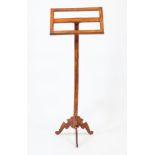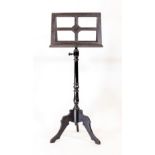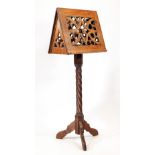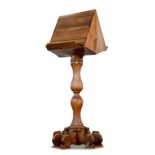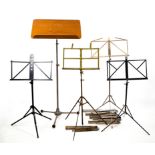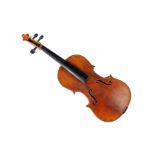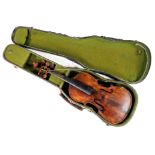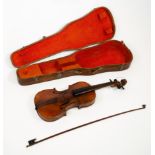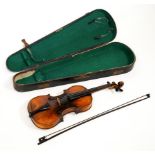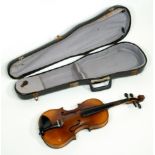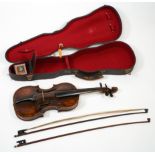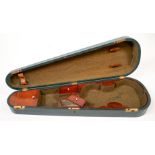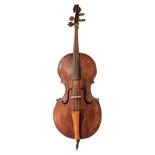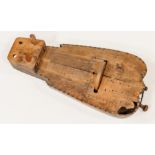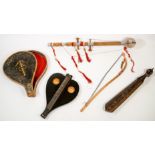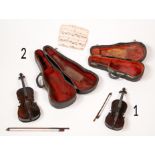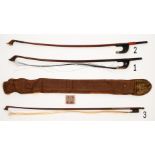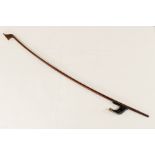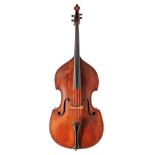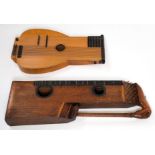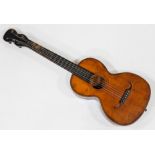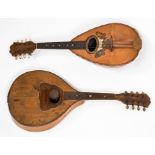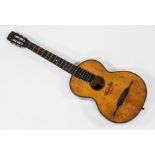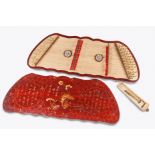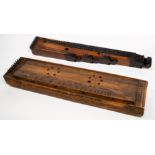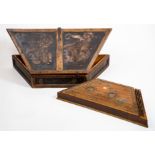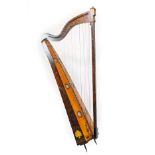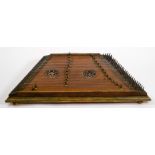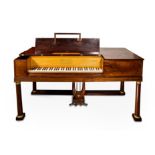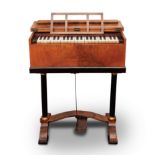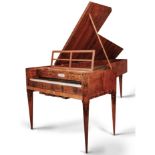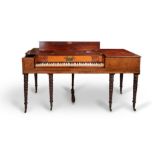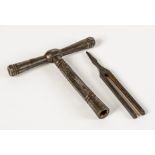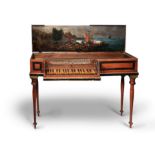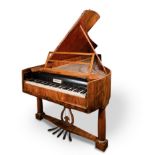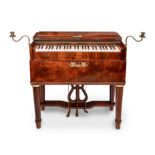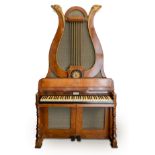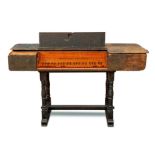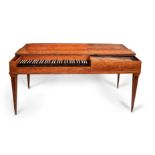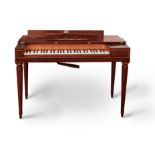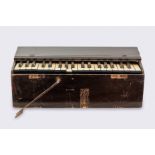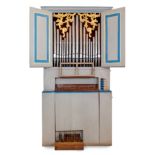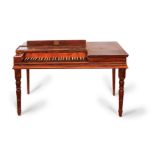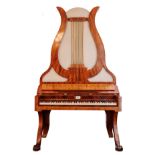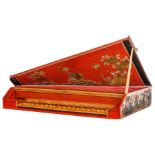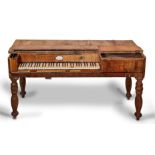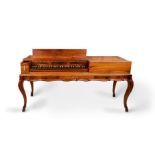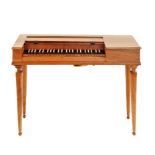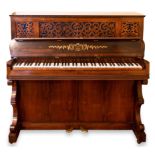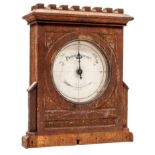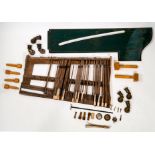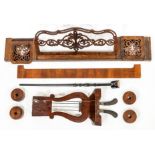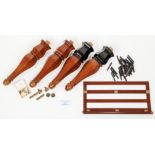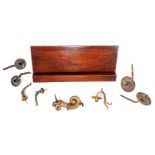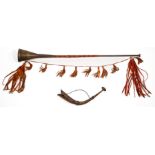Refine your search
Sale Section
- Bücher und Handschriften (6)
- Figuren und Skulpturen (14)
- Gemälde (14)
- Glas (1)
- Graphiken (38)
- Hinterglasbilder (7)
- Kamin-bzw. Ofenplatten (12)
- Möbel und Dekoration (39)
- Münzen und Medaillen (1)
- Musikinstrumente (140)
- Porzellan und Keramik (8)
- Religiöse Volkskunst (16)
- Uhren (1)
- Varia (8)
- Wein (1)
- Zeichnungen (5)
Category
- List
- Grid
-
318 item(s)/page
A subscription to the Price Guide is required to view results for auctions ten days or older. Click here for more information
BIEDERMEIER-NOTENPULT, NUSSBAUM, UM 1820Schlicht gehaltenes, schlankes Biedermeier-Notenpult, vermutlich Deutschland um 1820. Nussbaum massiv. Höh...
DOPPELNOTENPULT AUS HOLZ, UM 1860 Schwarz gefasstes, höhenverstellbares Doppel-Notenpult um 1860. Möglicherweise deutsch.Höhe: 135-150cm.WOODEN DU...
HÖLZERNES NOTENPULT, UM 1860 Blau gefasstes, höhenverstellbares Notenpult um 1860. Möglicherweise deutsch.Höhe: 125-160cm.WOODEN MUSIC STAND, CIRC...
DOPPELNOTENPULT MIT FLORALER SCHNITZEREI, EIFEL UM 1840Schweres Doppelnotenpult mit durchbrochener floraler Schnitzerei, massiv Eiche, Eifel um 18...
ITALIENISCHES NOTENPULT, UM 1700Farblich in Rot-, Gelb- und Brauntönen gefasstes Notenpult mit umlaufender Schnitzerei. Möglicherweise Venedig um ...
ITALIENISCHES CHORNOTENPULT, 17. JH.Imposantes, zweiseitiges Chor-Notenpult in massivem Nussbaum mit kunstvoll geschnitztem Fuß. Mit Notenfach, in...
KONVOLUT DIRIGENTENPULT HOLZ UND NOTENPULTE METALLKonvolut aus Dirigentenpult Holz, mit stabilem Metallgestell, verstellbar und zehn klappbaren En...
UNSIGNIERTE HISTORISCHE VIOLINEInteressante unsignierte 1/2 Violine, vermutlich in Markneukirchen im 19./20. Jh. hergestellt. Der Boden geteilt in...
UNSIGNIERTE HISTORISCHE VIOLINE MIT KASTENUnrestaurierte, unsignierte Violine, vermutlich 18. oder frühes 19. Jh. in einem alten Kunstlederkasten....
UNSIGNIERTE VIOLINE MIT BOGEN IN HISTORISCHEM HOLZKASTEN Unrestaurierte Violine in gutem Zustand mit Geigenbogen in Holzkasten. Das Instrument ist...
HISTORISCHE VIOLINE LUDOVICUS RICOZALI CREMONA MIT KASTEN UND BOGENHistorische, vermutlich sächsische oder böhmische Violine, signiert auf einem e...
ALTE VIOLINE MIT GEIGENKASTENDeutsche ¾ Violine aus der 1. Hälfte des 20. Jh. in gutem Zustand mit zweiteiligem Boden aus Ahorn, in einem mit Kuns...
HISTORISCHE ELEGANTE VIOLINE MIT VERZIERTEM BODEN UND PASSENDEM KASTENSächsische historische Violine aus dem frühen 19. Jh. in gutem Zustand mit o...
HISTORISCHE VIOLINE MIT BÖGEN UND KASTEN - REPARIERT JOHANN MAHLKE BERLINSächsische Violine mit durchgesetztem Originalhals aus Buchenholz und ein...
ELEGANTER GEIGENKASTEN MIT DREI SCHATULLEN, DEUTSCH, 19. JH.Eleganter Geigenkasten, deutsch, 1. Hälfte 19. Jh., mit drei eingebauten Mahagoni-Scha...
BASSETTL / HALBBASS, DEUTSCHLAND VERMUTLICH SACHSEN / EVTL. BÖHMEN, UM 1700Das sehr seltene, viersaitige Instrument mit Fichtendecke ist spielbar ...
DREHLEIER, UDELFANGEN BEI TRIER, UM 1800An dieser unrestaurierten, jedoch konservierten historischen Drehleier um 1800 sind zwei von vier Wirbeln ...
KONVOLUT PONTISCHE/KRETISCHE LYRA, STREICHZITHER UND INDISCHER RAAVAN HATHA, 20. JH.Die pontische Lyra besitzt Ähnlichkeit mit der Pochette und ha...
MINIATUR-CELLO UND MINIATUR-KONTRABASS, JEWEILS MIT BOGEN IM KASTENMiniatur-Cello und Miniatur-Kontrabass, jeweils mit Bogen im passenden Instrume...
KONVOLUT AUS ZWEI KONTRABASSBÖGEN UND EINEM GEIGENBOGENKonvolut aus 2 Kontrabassbögen und einem Geigenbogen. Alle Bögen weisen diverse Alters- und...
KONTRABASSBOGEN „EXPION“ VON EMILE AUGUSTE OUCHARD ET FILSEin gebrauchter Kontrabassbogen aus der berühmten französischen Bogenbaufamilie Ouchard....
UNSIGNIERTER KONTRABASS
UNSIGNIERTER KONTRABASSDas Instrument ist ein klassischer vierseitiger Kontrabass in Gambenform mit Fichtendecke und gewölbtem Ahornboden. Das Ins...
KONVOLUT HARFENZITHER UND STÖSSEL-BASSLAUTE, 20. JH.Konvolut bestehend aus bauchiger Zither/Harfenzither und einer Stössel-Basslaute/Stoessel’s La...
UNSIGNIERTE BIEDERMEIER-GITARRE, 19. JH.Das Instrument ist im Stil einer Biedermeier-Gitarre gebaut, wie sie unter anderem in Wien im 19. Jh. in G...
KONVOLUT: HISTORISCHE CISTER UND NEAPOLITANISCHE MANDOLINEKonvolut aus zwei historischen Zupfinstrumenten bestehend aus einer Cister und einer nea...
GITARRE MIT INTARSIEN-LANDSCHAFTSBILD, DEUTSCH UM 1920Historische, nicht signierte Gitarre mit einem Holzintarsien-Landschaftsbild: See vor Dorfhä...
YANG-TJIN ZITHER, CHINA, VERMUTLICH ANFANG BIS MITTE 20. JH.Diese trapezförmige Kastenzitter (Cetra trapezoidale a percussione – Yang Ch’in, Yang-...
KONVOLUT TAUBENSCHLAGZITHER UND KLEINKÖPFIGE ZITHER/CITERA, UNGARN, 19./20. JH. Das Konvolut besteht aus einer Taubenschlagzither und einer kleink...
PSALTERIUM UNSIGNIERT IN BEMALTEM HOLZKASTEN, WOMÖGLICH ITALIEN 18. JH.Dieses Psalterium (dt. Hackbrett, ital. Salterio, engl. hammered dulcimer) ...
BÖHMISCHE HAKENHARFE UM 1810
BÖHMISCHE HAKENHARFE UM 1810Diese Böhmische Hakenharfe um 1810 ist am oberen Ende des Resonanzbodens mit den Initialen „J“ [oder „S“?] und „P“ ver...
SALTERIO, IOANNES ANTONIUS CAPELLETTI, ITALIEN, TRIENT 1743Das vierchörige Instrument aus Trient wurde laut der eingeklebten Vignette 1743 von Joh...
TAFELKLAVIER ÉRARD FRÉRES, PARIS 1821Das Tafelklavier der Gebrüder Érard mit der Seriennummer 11581, wurde am 18.08.1821 in Paris fertig gestellt ...
HARMONIUM, ANTON HÄCKL ZUGESCHRIEBEN, WIEN UM 1825Das vorliegende Instrument wurde von Prof. Ewerhart dem Anton Häckl in Wien zugeschrieben. Desse...
HAMMERFLÜGEL VON JOHANN GEORG GRÖBER, INNSBRUCK UM 1815Der Hammerflügel wurde von Johann Georg Gröber (1775-1849) in Innsbruck gebaut. Gröber abso...
TAFELKLAVIER VON MUZIO CLEMENTI, LONDON UM 1810Das Tafelklavier von Muzio Clementi (1752-1832) wurde 1810 in London gebaut und trägt die beiden fü...
KONVOLUT AUS HISTORISCHEM STIMMSCHLÜSSEL UND EINER STIMMGABELDas Konvolut besteht aus einem historischen Stimmschlüssel mit sechseckig ausgeführte...
HISTORISCHES ITALIENISCHES CLAVICHORD, UNSIGNIERTDieses Clavichord ist außen mit schwarzen Kassetten auf rotem Grund bemalt. Die Innenseite des Ha...
WIENER HAMMERFLÜGEL, SIGNATUR VERLOREN, UM 1825-1830Der in Nussbaum furnierte Hammerflügel besitzt zwischen den beiden vorderen Beinen ein Pedalbr...
PHYSHARMONIKA VON MICHAEL SCHWEIGHOFER, WIEN UM 1830-1840Die Signatur in einem ovalen Messingrahmen weist auf den Klavierbauer Johann Michael Schw...
ITALIENISCHE ORGEL VON NICOLA MANCINI, NEAPEL 1766Die restaurierte mittelitalienische Orgel besitzt 9 Register. Der Klang dieses farbenprächtigen ...
LYRAFLÜGEL VON JOHANN CHRISTIAN SCHLEIP, BERLIN UM 1840-1845Der vorliegende Lyraflügel von Schleip weist unverkennbar freimaurerische Bezüge auf. ...
ITALIENISCHES VIRGINAL VON BAPTISTA CARGNONUS SALODIJ, SALO 1682Das Virginal von Baptista Cargnonus Salodij besitzt äußerlich eine unkaschierte Pa...
BUNDFREIES CLAVICHORD VON CHRISTOPH FRIEDRICH SCHMAHL, REGENSBURG 1805Das bundfreie Clavichord aus der Orgel- und Tasteninstrumentenbauerfamilie S...
KLEINES TAFELKLAVIER VON JOHANNES KILIANUS MERCKEN, PARIS 1797Das Tafelklavier von Johannes Kilianus Mercken (1743-1816) wurde 1797 in Paris herge...
UNSIGNIERTES FELDHARMONIUM, VERMUTLICH ÖSTERREICH UM 1910Feldharmonien wurden für den portablen Einsatz gebaut. Ein Hebel, welcher in das Loch an ...
HAMMERFLÜGEL SIGNIERT „C. GRAF“, VERMUTLICH WIEN 1820-1830Der Hammerflügel ist mit „Conrad Graf“ signiert. Diese Signatur ist unauthentisch und de...
UNSIGNIERTE ITALIENISCHE ORGEL MIT ANGEHÄNGTEM PEDAL, EMILIA ROMAGNA UM 1700Die einmanualige Orgel mit kurzer Oktav und Pedal besitzt 5 Register. ...
UNSIGNIERTES SÜDDEUTSCHES TAFELKLAVIER UM 1760-1780Das Instrument ist unsigniert. Das Gehäuse aus Weichholz ist nicht furniert und lediglich mit e...
LYRAFLÜGEL VON F.A. KLEIN, BERLIN UM 1830-1835F. A. Klein ist zwischen ca. 1825-1883 als Klavierbauer, Musikalienhändler und Instrumentenverleiher...
ITALIENISCHES UNSIGNIERTES OTTAVINO, OKTAVSPINETT WOMÖGLICH VENEDIG UM 1700Das vorliegende, trapezförmige, farblich gefasste Instrument, wurde zus...
TAFELKLAVIER VON CASPAR KATHOLNIG, WIEN UM 1815Das Tafelklavier von Caspar Katholnig (1763-1829) ist in Kirschfurnier furniert. Zwei Kniehebel bet...
DEUTSCHES TAFELKLAVIER VON JOHANN MATTHIAS SCHIFFMANN, DUSEMOND (BRAUNEBERG), UM 1780-1790Das Tafelklavier von Johann Matthias Schiffmann wurde zw...
UNSIGNIERTES KLEINES TAFELKLAVIER, PANTALON, MÖGLICHERWEISE ITALIEN UM 1770-1780Das kleine unsignierte, in massivem Nussbaum gefertigte Tafelklavi...
PIANINO VON THOMAS WARKER, TRIER UM 1845Thomas Warker, dessen Klaviermanufaktur nach der einschlägigen Fachliteratur zwischen 1845 und 1846 bestan...
PNEUMATOMETER, WINDDRUCKPRÜFER FÜR DEN ORGELBAUPneumatometer wurden im Orgelbau zur Ermittlung des Winddrucks im Windkanal und der Windlade verwen...
KONVOLUT HISTORISCHE KLAVIERTEILE UND DUSTCOVERKonvolut aus diversen Hammerklavier-Ersatz- und Reparaturteilen, wie auf dem Bild dargestellt. Unte...
KONVOLUT ERSATZTEILE FÜR EINEN HAMMERFLÜGEL, 19. JH.Konvolut aus Ersatzteilen für einen Flügel bestehend aus einer Deckelstütze, Notenpult, Lyra, ...
KONVOLUT AUS TEILEN EINES TAFELKLAVIERS UM 1840Konvolut aus Ersatzteilen von einem Tafelklavier von Georg Andreas Luckhardt, Kassel. Enthalten sin...
KONVOLUT AUS NOTENPULT UND KERZENHALTER FÜR ORGELINSTRUMENTEKonvolut aus einem Notenpult, 3 Paaren Kerzenhaltern und zwei einzelnen Kerzenhaltern ...
KONVOLUT SIGNALTROMPETE UND KANGLING (TIBET) IN FORM EINES DRACHENKonvolut bestehend aus zwei Blechblasinstrumenten mit Alters- und Gebrauchsspure...
-
318 item(s)/page


